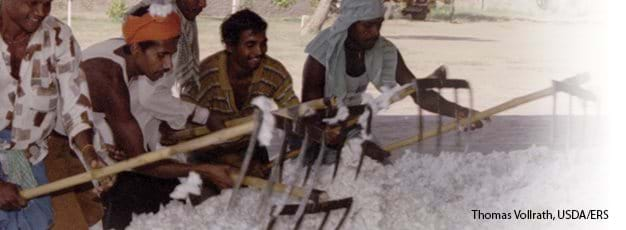Indian Cotton Yield Gains Could Limit Imports

Adoption of hybrid Bacillus thuringiensis (Bt) cotton by Indian farmers is helping to boost cotton yields and may dampen growth in the cotton that India imports to meet the needs of its expanding textile industry. Bt cotton varieties are genetically engineered to include a gene (from the soil bacterium Bacillus thuringiensis) that enables the plant to produce its own natural toxins to defend against bollworms and certain other pests. Bt cotton hybrids were first approved for cultivation in India in 2002 and, by the 2004/05 crop year, Bt cotton accounted for 17 percent of India’s cotton area—some 1.5 million hectares. The pace of adoption and yield gains appear poised to accelerate. During May-June 2005, 14 new Bt varieties were approved, including the first-ever varieties for heavily irrigated areas in North India.
Although it is too soon to be sure of overall impacts, Bt cotton adoption appears likely to increase yields significantly. Recent region-specific studies in India found that Bt hybrids improved yields by 45-87 percent. The yield gains reported in India contrast sharply with the U.S. experience, where the primary impact of Bt cotton has been reduced costs. The main reason for the difference is that Indian cotton farmers—most of whom operate small holdings with limited resources—typically do not practice optimal pest control. By controlling boring insects, Bt varieties provide significant yield gains. Cost savings relative to non-Bt varieties appear less substantial for Indian farmers because Bt seed prices are relatively high compared with non-Bt seeds.
The scope is broad for increasing cotton yields in India, where yields are below the world average and the lowest of the top-10 global producers. Although Bt technology does not address some important yield constraints, including erratic rainfall, use of uncertified seeds, and poor cultivation practices, improved pest protection appears to be having an impact. Damage from bollworms is a key yield constraint in all producing regions of India, particularly the heavily irrigated and potentially high-yielding areas of North India.
Because India’s 8-9 million hectares of cotton area is by far the largest of any country in the world, yield gains could significantly affect global markets. Rising incomes in India and increased exports of cotton-based textiles associated with the end—in January 2005—of developed-country import quotas under the Multi-Fiber Arrangement (MFA) are now boosting growth in India’s demand for domestic and imported cotton. India is among several developing, textile-producing countries expected to increase their shares of global textile trade in the post-MFA environment. If India can supply more of its expanding textile sector with domestically produced cotton, opportunities for the United States and other cotton exporters will decline.
Growth Prospects for India's Cotton and Textile Industries, by Maurice Landes, Stephen MacDonald, Santosh K. Singh, and Thomas Vollrath, USDA, Economic Research Service, June 2005


